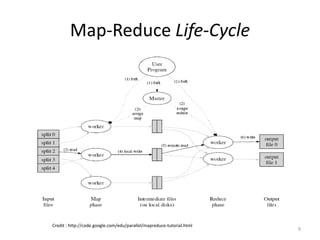Hadoop & HDFS for Beginners
- 1. Hadoop Rahul Jain Software Engineer http://www.linkedin.com/in/rahuldausa 1
- 2. Agenda • Hadoop – Introduction – Hadoop (Why) – Hadoop History – Uses of Hadoop – High Level Architecture – Map-Reduce • HDFS – GFS (Google File System) – HDFS Architecture • Installation/Configuration • Examples 2
- 3. Introduction An open source software framework Supports Data intensive Distributed Applications. Enables Application to work thousand of computational independent computers and petabytes of data. Derived from Google’s Map-Reduce and Google File System papers. Written in the Java Programming Language. Started by Doug Cutting, who named it after his son’s toy elephant to support distribution for the Nutch ( A sub-project of Lucene) 3
- 4. Hadoop (Why) • Need to process huge datasets on large no. of computers. • It is expensive to build reliability into each application. • Nodes fails everyday - Failure is expected, rather than exceptional. - Need common infrastructure - Efficient, reliable, easy to use. - Open sourced , Apache License 4
- 5. Hadoop History • Dec 2004 – Google GFS paper published • July 2005 – Nutch uses Map-Reduce • Jan 2006 – Doug Cutting joins Yahoo! • Feb 2006 – Become Lucene Subproject • Apr 2007 – Yahoo! On 1000 node cluster • Jan 2008 – An Apache Top Level Project • Feb 2008 – Yahoo Production search index 5
- 6. What is Hadoop Used for ? • Searching (Yahoo) • Log Processing • Recommendation Systems (Facebook, LinkedIn, eBay, Amazon) • Analytics(Facebook, LinkedIn) • Video and Image Analysis (NASA) • Data Retention 6
- 7. Hadoop High Level Architecture 7
- 8. Map-Reduce Framework for processing parallel problems across huge datasets using a large numbers of computers(nodes), collectively referred as Cluster : If all nodes are on same local network and uses similar network. Or Grid: If the nodes are shared across geographically and uses more heterogeneous hardware. Consists Two Step : 1.Map Step- The master node takes the input, divides it into smaller sub-problems, and distributes them to worker nodes. A worker node may do this again in turn, leading to a multi-level tree structure. The worker node processes the smaller problem, and passes the answer back to its master node. 2.Reduce Step -The master node then collects the answers to all the sub-problems and combines them in some way to form the output – the answer to the problem it was originally trying to solve. Multiple Map-Reduce phases 8
- 9. Map-Reduce Life-Cycle Credit : http://code.google.com/edu/parallel/mapreduce-tutorial.html 9
- 10. HDFS Hadoop Distributed File System 10
- 11. Lets Understand GFS first … Google File System 11
- 12. GFS Architecture 12
- 13. Goals of HDFS 1. Very Large Distributed File System - 10K nodes, 100 million files, 10 PB 2. Assumes Commodity Hardware - Files are replicated to handle hardware failure - Detect failures and recovers from them 3. Optimized for Batch Processing - Data locations exposed so that computation can move to where data resides. 13
- 14. 14
- 15. Installation/ Configuration [[email protected] hadoop-1.0.3]$ vi conf/hdfs-site.xml [[email protected] hadoop-1.0.3]$ pwd <configuration> /home/rjain/hadoop-1.0.3 <property> <name>dfs.replication</name> [[email protected] hadoop-1.0.3]$ bin/start-all.sh <value>1</value> </property> [[email protected] hadoop-1.0.3]$ bin/start-mapred.sh <property> <name>dfs.permissions</name> [[email protected] hadoop-1.0.3]$ bin/start-dfs.sh <value>true</value> </property> [[email protected] hadoop-1.0.3]$ bin/hadoop fs <property> Usage: java FsShell <name>dfs.data.dir</name> [-ls <path>] <value>/home/rjain/rahul/hdfs/data</value> [-lsr <path>] : Recursive version of ls. Similar to Unix ls -R. </property> [-du <path>] : Displays aggregate length of files contained in the directory or the length of a file. <property> [-dus <path>] : Displays a summary of file lengths. <name>dfs.name.dir</name> [-count[-q] <path>] <value>/home/rjain/rahul/hdfs/name</value> [-mv <src> <dst>] </property> [-cp <src> <dst>] </configuration> [-rm [-skipTrash] <path>] [-rmr [-skipTrash] <path>] : Recursive version of delete(rm). [[email protected] hadoop-1.0.3]$ vi conf/mapred-site.xml [-expunge] : Empty the Trash <configuration> [-put <localsrc> ... <dst>] : Copy single src, or multiple srcs from local file system to the <property> destination filesystem <name>mapred.job.tracker</name> [-copyFromLocal <localsrc> ... <dst>] <value>localhost:9001</value> [-moveFromLocal <localsrc> ... <dst>] </property> [-get [-ignoreCrc] [-crc] <src> <localdst>] </configuration> [-getmerge <src> <localdst> [addnl]] [-cat <src>] [[email protected] hadoop-1.0.3]$ vi conf/core-site.xml [-text <src>] : Takes a source file and outputs the file in text format. The allowed formats are zip <configuration> and TextRecordInputStream. <property> [-copyToLocal [-ignoreCrc] [-crc] <src> <localdst>] <name>fs.default.name</name> [-moveToLocal [-crc] <src> <localdst>] <value>hdfs://localhost:9000</value> [-mkdir <path>] </property> [-setrep [-R] [-w] <rep> <path/file>] : Changes the replication factor of a file </configuration> [-touchz <path>] : Create a file of zero length. [-test -[ezd] <path>] : -e check to see if the file exists. Return 0 if true. -z check to see if the file is [[email protected] hadoop-1.0.3]$ jps zero length. Return 0 if true. -d check to see if the path is directory. Return 0 if true. 29756 SecondaryNameNode [-stat [format] <path>] : Returns the stat information on the path like created time of dir 19847 TaskTracker [-tail [-f] <file>] : Displays last kilobyte of the file to stdout 18756 Jps [-chmod [-R] <MODE[,MODE]... | OCTALMODE> PATH...] 29483 NameNode [-chown [-R] [OWNER][:[GROUP]] PATH...] 29619 DataNode [-chgrp [-R] GROUP PATH...] 15 19711 JobTracker [-help [cmd]]
- 16. HDFS- Read/Write Example Configuration conf = new Configuration(); FileSystem fs = FileSystem.get(conf); Given an input/output file name as string, we construct inFile/outFile Path objects. Most of the FileSystem APIs accepts Path objects. Path inFile = new Path(argv[0]); Path outFile = new Path(argv[1]); Validate the input/output paths before reading/writing. if (!fs.exists(inFile)) printAndExit("Input file not found"); if (!fs.isFile(inFile)) printAndExit("Input should be a file"); if (fs.exists(outFile)) printAndExit("Output already exists"); Open inFile for reading. FSDataInputStream in = fs.open(inFile); Open outFile for writing. FSDataOutputStream out = fs.create(outFile); Read from input stream and write to output stream until EOF. while ((bytesRead = in.read(buffer)) > 0) { out.write(buffer, 0, bytesRead); } Close the streams when done. in.close(); out.close(); 16
- 17. Hadoop Sub-Projects • Hadoop Common: The common utilities that support the other Hadoop subprojects. • Hadoop Distributed File System (HDFS™): A distributed file system that provides high-throughput access to application data. • Hadoop MapReduce: A software framework for distributed processing of large data sets on compute clusters. Other Hadoop-related projects at Apache include: • Avro™: A data serialization system. • Cassandra™: A scalable multi-master database with no single points of failure. • Chukwa™: A data collection system for managing large distributed systems. • HBase™: A scalable, distributed database that supports structured data storage for large tables. • Hive™: A data warehouse infrastructure that provides data summarization and ad hoc querying. • Mahout™: A Scalable machine learning and data mining library. • Pig™: A high-level data-flow language and execution framework for parallel computation. • ZooKeeper™: A high-performance coordination service for distributed applications. 17
- 18. Questions ? 18















![Installation/ Configuration
[rjain@10.1.110.12 hadoop-1.0.3]$ vi conf/hdfs-site.xml [rjain@10.1.110.12 hadoop-1.0.3]$ pwd
<configuration> /home/rjain/hadoop-1.0.3
<property>
<name>dfs.replication</name>
[rjain@10.1.110.12 hadoop-1.0.3]$ bin/start-all.sh
<value>1</value>
</property> [rjain@10.1.110.12 hadoop-1.0.3]$ bin/start-mapred.sh
<property>
<name>dfs.permissions</name>
[rjain@10.1.110.12 hadoop-1.0.3]$ bin/start-dfs.sh
<value>true</value>
</property> [rjain@10.1.110.12 hadoop-1.0.3]$ bin/hadoop fs
<property> Usage: java FsShell
<name>dfs.data.dir</name> [-ls <path>]
<value>/home/rjain/rahul/hdfs/data</value> [-lsr <path>] : Recursive version of ls. Similar to Unix ls -R.
</property> [-du <path>] : Displays aggregate length of files contained in the directory or the length of a file.
<property> [-dus <path>] : Displays a summary of file lengths.
<name>dfs.name.dir</name> [-count[-q] <path>]
<value>/home/rjain/rahul/hdfs/name</value> [-mv <src> <dst>]
</property> [-cp <src> <dst>]
</configuration> [-rm [-skipTrash] <path>]
[-rmr [-skipTrash] <path>] : Recursive version of delete(rm).
[rjain@10.1.110.12 hadoop-1.0.3]$ vi conf/mapred-site.xml [-expunge] : Empty the Trash
<configuration> [-put <localsrc> ... <dst>] : Copy single src, or multiple srcs from local file system to the
<property> destination filesystem
<name>mapred.job.tracker</name> [-copyFromLocal <localsrc> ... <dst>]
<value>localhost:9001</value> [-moveFromLocal <localsrc> ... <dst>]
</property> [-get [-ignoreCrc] [-crc] <src> <localdst>]
</configuration> [-getmerge <src> <localdst> [addnl]]
[-cat <src>]
[rjain@10.1.110.12 hadoop-1.0.3]$ vi conf/core-site.xml [-text <src>] : Takes a source file and outputs the file in text format. The allowed formats are zip
<configuration> and TextRecordInputStream.
<property> [-copyToLocal [-ignoreCrc] [-crc] <src> <localdst>]
<name>fs.default.name</name> [-moveToLocal [-crc] <src> <localdst>]
<value>hdfs://localhost:9000</value> [-mkdir <path>]
</property> [-setrep [-R] [-w] <rep> <path/file>] : Changes the replication factor of a file
</configuration> [-touchz <path>] : Create a file of zero length.
[-test -[ezd] <path>] : -e check to see if the file exists. Return 0 if true. -z check to see if the file is
[rjain@10.1.110.12 hadoop-1.0.3]$ jps zero length. Return 0 if true. -d check to see if the path is directory. Return 0 if true.
29756 SecondaryNameNode [-stat [format] <path>] : Returns the stat information on the path like created time of dir
19847 TaskTracker [-tail [-f] <file>] : Displays last kilobyte of the file to stdout
18756 Jps [-chmod [-R] <MODE[,MODE]... | OCTALMODE> PATH...]
29483 NameNode [-chown [-R] [OWNER][:[GROUP]] PATH...]
29619 DataNode [-chgrp [-R] GROUP PATH...] 15
19711 JobTracker [-help [cmd]]](https://image.slidesharecdn.com/hadoop-for-beginners-130112031616-phpapp02/85/Hadoop-HDFS-for-Beginners-15-320.jpg)
![HDFS- Read/Write Example
Configuration conf = new Configuration();
FileSystem fs = FileSystem.get(conf);
Given an input/output file name as string, we construct inFile/outFile Path objects.
Most of the FileSystem APIs accepts Path objects.
Path inFile = new Path(argv[0]);
Path outFile = new Path(argv[1]);
Validate the input/output paths before reading/writing.
if (!fs.exists(inFile))
printAndExit("Input file not found");
if (!fs.isFile(inFile))
printAndExit("Input should be a file");
if (fs.exists(outFile))
printAndExit("Output already exists");
Open inFile for reading.
FSDataInputStream in = fs.open(inFile);
Open outFile for writing.
FSDataOutputStream out = fs.create(outFile);
Read from input stream and write to output stream until EOF.
while ((bytesRead = in.read(buffer)) > 0) {
out.write(buffer, 0, bytesRead);
}
Close the streams when done.
in.close();
out.close();
16](https://image.slidesharecdn.com/hadoop-for-beginners-130112031616-phpapp02/85/Hadoop-HDFS-for-Beginners-16-320.jpg)

